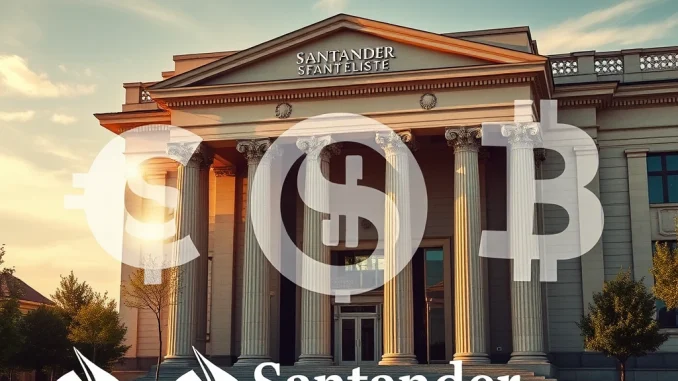
Reports suggest Spanish banking heavyweight Santander is taking a serious look at the world of digital assets. The focus? Early-stage plans for a Santander crypto initiative, specifically centered around a bank stablecoin.
What Are Santander’s Plans for a Bank Stablecoin?
According to information circulating, including a report from Unfolded on X, Santander is in the preliminary stages of exploring a move into the cryptocurrency market. This isn’t about diving headfirst into volatile assets like Bitcoin or Ethereum, but rather starting with something designed for stability: a stablecoin. A stablecoin is a type of cryptocurrency whose value is pegged to another asset, typically a fiat currency like the Euro or US Dollar. For a major financial institution like Santander, a stablecoin offers a way to leverage blockchain technology while mitigating the price volatility inherent in many cryptocurrencies.
While details remain sparse as these are described as ‘early plans’, the potential use cases for a Santander-issued stablecoin are numerous. It could be used for faster, cheaper cross-border payments, facilitating instant settlements between businesses, or even potentially integrating into future digital finance products offered to their vast customer base. The move signals a potential shift in how large banks view and plan to interact with the evolving digital currency landscape.
Why Are Financial Institutions Exploring Crypto?
Santander isn’t alone in this exploration. A growing number of financial institutions crypto strategies are emerging globally. The reasons behind this trend are multifaceted:
- Efficiency Gains: Blockchain technology can streamline processes like payments and settlements, reducing costs and time compared to traditional systems.
- New Revenue Streams: Offering crypto-related services, from custody to tokenization and stablecoin issuance, opens up new business opportunities.
- Keeping Pace with Innovation: The financial sector recognizes that digital assets are not a fleeting trend but a significant technological shift that could reshape finance.
- Customer Demand: Both retail and institutional clients are increasingly interested in accessing and using digital assets.
- Future-Proofing: As central banks explore Central Bank Digital Currencies (CBDCs) and private stablecoins gain traction, banks need to develop their own strategies to remain relevant.
This broader trend indicates a significant maturation of the crypto market, moving beyond early adopters to attract interest from established players like Santander.
How Could Bank Stablecoins Impact Crypto Adoption?
The potential entry of major banks like Santander into the stablecoin space could have a profound impact on mainstream crypto adoption. Here’s why:
When a trusted, regulated entity like Santander issues a stablecoin, it brings with it a level of credibility and familiarity that many existing stablecoins might lack for the average user or traditional business. This could:
- Increase Trust: Customers who are hesitant about unregulated crypto might feel more comfortable using a stablecoin issued by their bank.
- Provide Regulatory Clarity: Bank-issued stablecoins are likely to operate within existing regulatory frameworks, addressing a major concern for businesses and individuals.
- Facilitate Integration: These stablecoins could be more easily integrated into existing banking infrastructure and services, making them accessible through familiar interfaces.
- Drive Institutional Use: Businesses and corporations may be more willing to use stablecoins issued by known banking partners for transactions and treasury management.
While existing stablecoins like USDT or USDC have large market caps, a bank stablecoin from a global player like Santander could tap into a vast network of customers and existing financial relationships, potentially accelerating the use of digital currencies for everyday transactions and financial activities.
What Challenges Does Santander Crypto Face?
While the prospect of a Santander crypto offering is exciting, the path is not without hurdles. Banks exploring this space face several significant challenges:
Regulatory Uncertainty: The regulatory landscape for stablecoins and other digital assets is still evolving globally. Navigating different rules across jurisdictions is complex.
Technological Integration: Integrating blockchain technology and digital asset infrastructure into complex legacy banking systems is a massive technical undertaking.
Competition: Santander’s stablecoin would compete not only with existing private stablecoins but also potentially with future CBDCs and traditional payment systems.
Internal Resistance: Large organizations often face internal challenges related to adopting new technologies and business models.
Security Risks: Dealing with digital assets requires robust cybersecurity measures to protect against hacks and fraud.
Successfully launching and scaling a bank stablecoin will require Santander to overcome these significant obstacles, necessitating careful planning, investment, and collaboration with regulators.
What Does This Mean for Digital Currency?
Santander’s reported exploration of a stablecoin is more than just news about one bank; it’s indicative of a broader trend shaping the future of digital currency. We are seeing a convergence of traditional finance and the digital asset space. This could lead to a future where:
- Digital currencies are seamlessly integrated into everyday banking services.
- Cross-border payments become near-instant and significantly cheaper.
- Tokenized assets become commonplace, representing everything from real estate to stocks on a blockchain.
- Competition between traditional banks, fintechs, and central banks drives innovation in digital payments and finance.
The move by financial institutions crypto exploration highlights the increasing inevitability of digital assets playing a central role in the global financial system. Whether it’s through private stablecoins like the one Santander is reportedly considering, or state-issued CBDCs, the way we transact and hold value is set to change dramatically.
Conclusion: A Glimpse into the Future of Finance
Santander’s early plans for a stablecoin, if they come to fruition, represent a significant moment in the intersection of traditional banking and the crypto world. It underscores the growing recognition among major financial players that digital assets, particularly stablecoins, offer compelling opportunities for efficiency, innovation, and staying competitive in an increasingly digital economy. While challenges remain, the exploration by a bank of Santander’s stature is a powerful signal for the continued maturation and potential widespread adoption of digital currencies in the global financial landscape. Keep watching this space; the future of finance is arriving, one stablecoin plan at a time.



